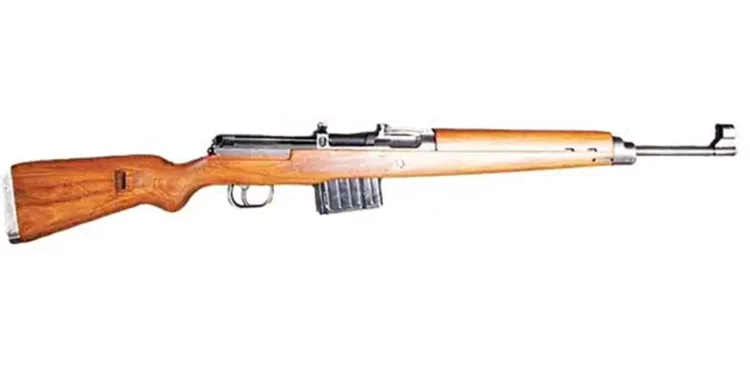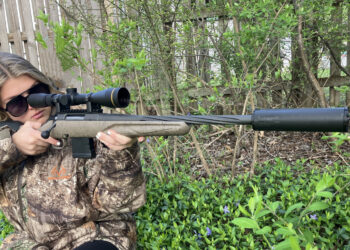Story & Photography by Peter Suciu
The Second World War was one of great technological advances. It was first war to see the use of jet aircraft and radar in combat, and it was fortunately the only time the atomic bomb was actually used as a weapon against an enemy city. One area that saw the most progress was small arms development—at the start of the War, many of the infantry weapons could rightfully be described as “antiquated.”
Almost all of the major combatant powers were using bolt-action rifles that were little improved from those used during World War I. Only the French Army seemed to be best prepared for another conflict; its Army developed a shorter bolt-action rifle, the MAS-36, a weapon designed with trench warfare in mind. Yet the German blitzkrieg ensured a quick victory, and as a result, the French small arm proved completely inadequate for this new type of fast moving warfare.
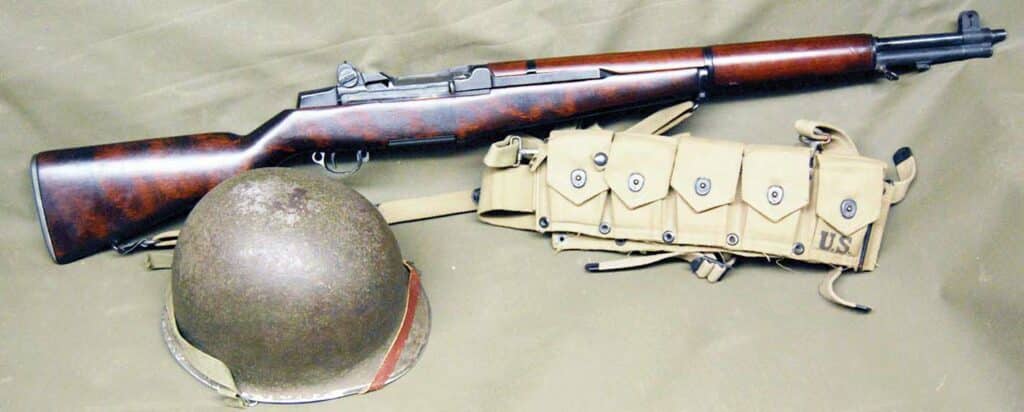
Type: Semiautomatic battle rifle
Caliber: .30-06 Springfield
Weight: 9.5lb
Length: 43.5in
Barrel Length: 24in
Capacity: 8-round “en bloc” clip
Fire Modes: Semiautomatic
Muzzle Velocity: 2,800 ft/s
Effective Range: 500 yards (457m)
All of the soon-to-be combatant armies sought to develop weapons that could provide offensive mobility. The Germans developed the first general purpose machine gun with its MG-34, while also making advances with submachine guns in the late 1930s. The Soviet Red Army, which was modernizing and undergoing post-purge reforms, learned valuable lessons in the brutal Winter War against Finland.
In the post-World War I era, the U.S. military had an arsenal of reliable weapons including the Browning M1919 .30 caliber machine gun and the Thompson M1928A1. But where the U.S. ingenuity proved forward thinking was in the development of a semiautomatic main battle rifle.
The Europeans may have created various automatic weapons, but the fact remained that when the War broke out, most of the soldiers of Europe were still carrying bolt-action rifles that had been developed two generations earlier. By contrast, when the United States entered the War it went into action with the M1 Garand, which General George S. Patton described as “the greatest battle implement ever devised.”
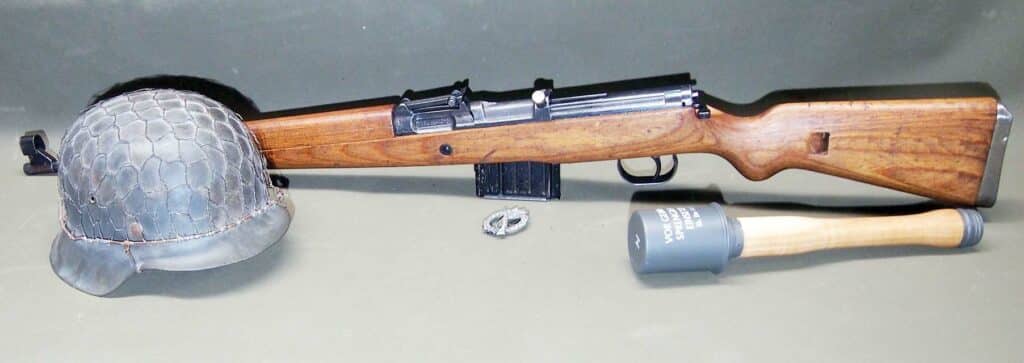
Type: Semiautomatic battle rifle
Caliber: 7.92x57mm Mauser
Weight: 9.7lb
Length: 44.5in
Barrel Length: 21.5in
Fire Modes: Semiautomatic
Action: Gas-operated short-stroke piston, flapper locking
Muzzle Velocity: 2,448–2,546 ft/s
Effective Range: 550 yards (500m)
Enter the Garand
Whether it was the greatest battle implement is a matter of debate. However, the rifle gave U.S. GIs a serious advantage on the battlefields across Europe and the Pacific. Some 5.5 million M1 Garands were manufactured, offering a higher rate of fire over the bolt-action rifles used by the enemy, while also utilizing a larger caliber cartridge than the submachine guns of the era.
The origins of the M1 went back to the First World War, when American military planners had seen that bolt-action rifles weren’t providing enough offensive firepower. This lead to the development of the Browning Automatic Rifle (BAR) and even the Thompson submachine gun, but it was clear that there needed to be a replacement to the standard infantry rifle.

During World War I there were attempts to improve the rate of fire with bolt-action rifles, and one of these included a unique design from John Douglas Pedersen. Aptly named the “Pedersen Device,” it was actually just an at enabled the rifle to fire a .30 caliber pistol cartridge in a semiautomatic mode. It didn’t have any impact on World War I, but it did inspire the U.S. military to consider the need for a new semiautomatic rifle. Numerous firearms designers lent their talent towards the development of such a weapon.
One competitor to the M1 Garand was Melvin Johnson’s M1941 Johnson Rifle, which unlike the designs by Pedersen and Thompson, actually saw some use in World War II. Some 70,000 were produced—making it a rare and desirable rifle for WWII small arms collectors. The Johnson Rifle utilized energy from recoil along with a rotating bolt—a revolutionary design, which had less recoil than the M1, as well as a greater magazine capacity. In the end, however, the Garand design won out, which itself was no small feat.

The M1 Garand was not perfect out of the gate, and it actually took the Canadian-born John C. Garand nearly 15 years to perfect the weapon. It featured an operating system similar to the Johnson design that included its gas-operated, rotating bolt. The M1 Garand could fire 40-50 rounds a minute, which was a considerable step up from most bolt-action rifles of the era. It also featured a rear adjustable aperture sight and front wing protected post, and most importantly, the rifle was designed to fire the .30-06 Springfield cartridge. That was same cartridge used with the M1903 Springfield bolt-action rifle, the BAR and the .30 caliber Browning machine gun.
The Soviet’s SVT-40
With its iconic PPSh-41 submachine gun— not to mention T-34 tank—it is somewhat understandable that a largely forgotten piece of Soviet equipment is the SVT-40, the Red Army’s first large scale attempt at a semiautomatic rifle. One reason it was widely forgotten is that despite the advantages the weapon offered, by War’s end it was largely withdrawn from service, yet it remains an important part of Soviet small arms design legacy. The Samozaryadnaya Vintovka Tokareva (“Tokarev self-loading rifle, Model 1940”), or SVT-40, has often been mislabeled as the “Soviet’s take on the M1 Garand” by gun collectors. But this isn’t close to accurate in no small part due to the fact that gun designer Fedor Tokarev had been working on his design essentially at the same time that Garand was refining his semiautomatic rifle.
There were big differences in how each of the weapons was developed. One key difference is that in a democracy, multiple designers were competing for a contract, while in the Soviet Union fear of a one-way trip to the gulag, or worse, a bullet in the head, were often the greater motivators! Moreover, John Garand spent 15 years developing the rifle bearing his name—his only real claim to fame—Tokarev was an established gun designer who created the TT-30 and TT-33 self-loading (semiautomatic) pistols.

Red Army female sniper Lyudmila Pavlichenko—who earned the nickname “Lady Death” and was credited with killing 309 Axis soldiers—used a sniper version of the SVT-40.
Tokarev also developed a submachine gun prototype, but in the 1930s turned his attention back to a semiautomatic rifle. The first version entered service in 1938 as the SVT-38, which fired the same 7.62x54mmR cartridge as the Mosin-Nagant. It featured a gas-operated action along with a gas cylinder cup. By Soviet standards it was a complex weapon, and when it was used in the Winter War with Finland (1939-1940), it wasn’t well received by the Red Army. Soldiers reported that the gun was too long, difficult to maintain, and worst of all, it had a removable box magazine that had a tendency to fall out at inopportune times. The SVT-38 was also not well-suited to the Soviet’s corrosively primed ammunition, and it required near constant cleaning—something the Mosin-Nagant rarely required. Due to the shortcomings, production of the SVT-38 ceased by summer 1940, and only some 150,000 units were produced.
Such a failure could have earned Tokarev that trip to Siberia (or worse), but Josef Stalin’s purges of the Soviet Red Army had taken their toll. The country was unprepared for the coming war with Germany; Tokarev was given another chance, and he immediately refined his semiautomatic design and designated the new weapon as SVT-40. It was lighter, less cumbersome and, more importantly for a nation that faced a massive onslaught, it was much simpler to produce.
Original plans were to replace the Model 1891/1930 Mosin-Nagant with the semiautomatic rifle, with upwards of one third of all soldiers being supplied with the SVT-40 within just a couple years. The German invasion in June 1941 derailed those plans, and worst of all, hundreds of thousands of the SVT-40s were captured. By winter, the Soviets were fighting for dear life. As a result, the Soviet military stuck with the Mosin-Nagant, as it was easier to produce, but the close combat firepower of the PPSh-41 was also recognized. The nation was under siege, and it was impossible to keep up production of all three weapons. While about a million SVT-40s had been produced by late 1941, the number actually declined as the War continued. By the end of the “Great Patriotic War”—as the Soviets dubbed World War II—only some 1.6 million SVT-40s were produced.
The semiautomatic rifle that Tokarev had worked so hard to develop and refine thus had far less impact on the War than the American M1 Garand. However, its design was noted by the Germans.

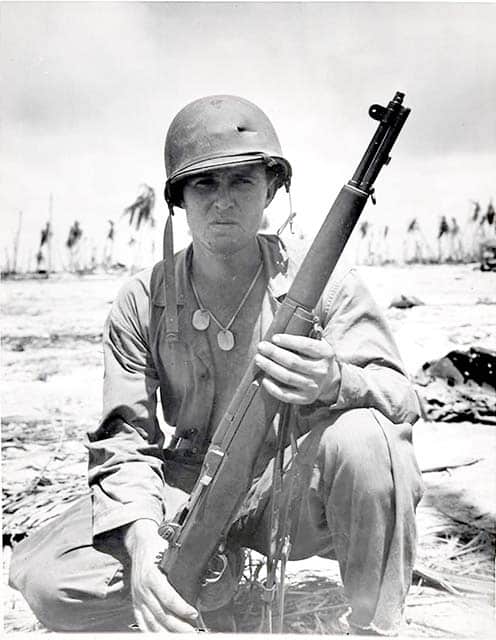
The German Gewehr 43
During the 1930s, the German military had
rearmed, which led to the adoption of the new MG-34 general purpose machine gun, and later the MP-38/40, the iconic and erroneously named “Schmeisser” submachine gun, but even in 1941 with the invasion of the Soviet Union, the German military was still largely equipped with the Kar 98k bolt-action rifle.
In 1941 the German military sought to develop a semiautomatic rifle, and two different firms—Mauser and Walther—were charged with its development. Nearly 13,000 Mauser patterns were produced, but neither it nor the Walther design proved reliable enough or did not meet the military’s demands. Instead, the designers looked to captured stocks of the Soviet SVT-40 and noted the simple gas mechanism.
The resulting Gewehr 43, or G43 as it has become known, has been dubbed the “German M1Garand” by firearms enthusiasts. However, the G43 has nothing in common with the M1 Garand. It would be fairer to suggest it was the German take on the SVT-40’s action while taking elements from the Mauser-developed G41(W). The gun was accepted and entered service originally as the Gewehr 43 in October 1943. However, due to the fact that the main bolt-action rifle was officially a “Karabiner” (carbine), and Gewehr meant “long rifle,” in 1944 the weapon was re-designated the Karabiner (K43). The two are identical in every way apart from the letters stamped on the side. Even today among collectors the rifle is generally known as the G43, while some published sources use the K43 nomenclature.
German military doctrine was to provide each infantry company with 19 G43s, including 10 that would be fitted with scopes for marksmen. However, as the War effort turned against the Germans, this goal was never achieved.
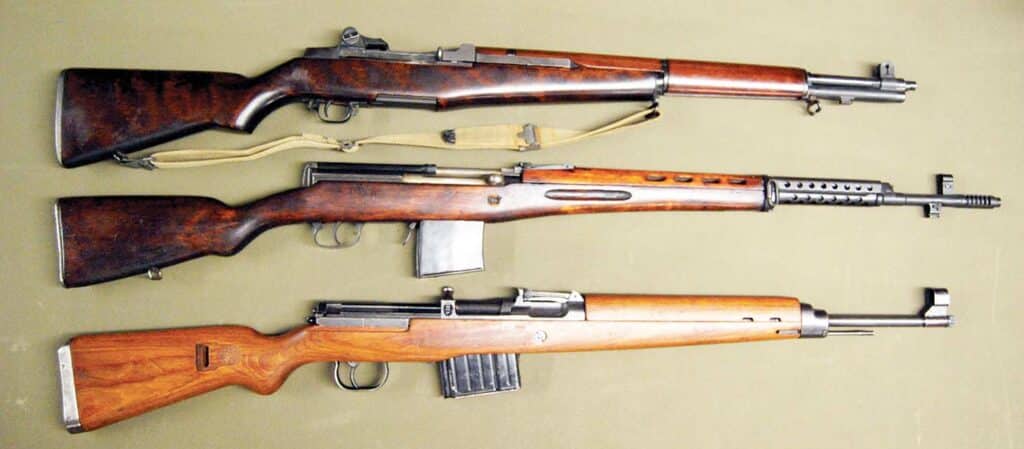
Lock and Load
While all three rifles saw use during the Second World War, as noted, the M1 Garand has largely gone down as a major success—notably when compared to the Soviet’s SVT-40, which didn’t perform up to expectations. The German G43 also came up short compared to the M1 Garand.
Moreover, it should be remembered that all three rifles were ideal for the combat requirements of World War II, but all three were obsolete by the early 1950s. The M1 Garand saw use in the Korean War (1950-1953) and remained in service until 1959. While ahead of its time in the 1930s, it had a few notable shortcomings. One of the unique features of the M1 was its “en bloc” clip, which held eight rounds. This allowed for quick reloading of the rifle, where the clip was inserted with a push by the thumb, but one major downside was that if done incorrectly, the bolt could slam on the operator’s thumb, resulting in the all-too-common “M1 thumb!” It also couldn’t be “topped off” with extra bullets.
By contrast, both the SVT-40 and G43 featured 10-round detachable magazines. This allowed for reloading by changing the magazine or by feeding five-round stripper clips. The M1 Garand had a significant advantage in offering higher capacity compared to the German’s Kar 98k, but this advantage was lost on those times when the Garand went up against the G43.
Of the three rifles, the G43 is the heaviest, but each comes in under 10 pounds. The SVT-40, at 48.3 inches, is the longest, and it’s just slightly shorter than the Model 91/30 Mosin-Nagant (itself a shortened version of the original M91 Mosin-Nagant). The M1 Garand also had an effective range of 500 yards, slightly less than the 550 yards of both the SVT-40 and G43; however, that 50-yard difference could be largely a moot point depending on the respective shooter.
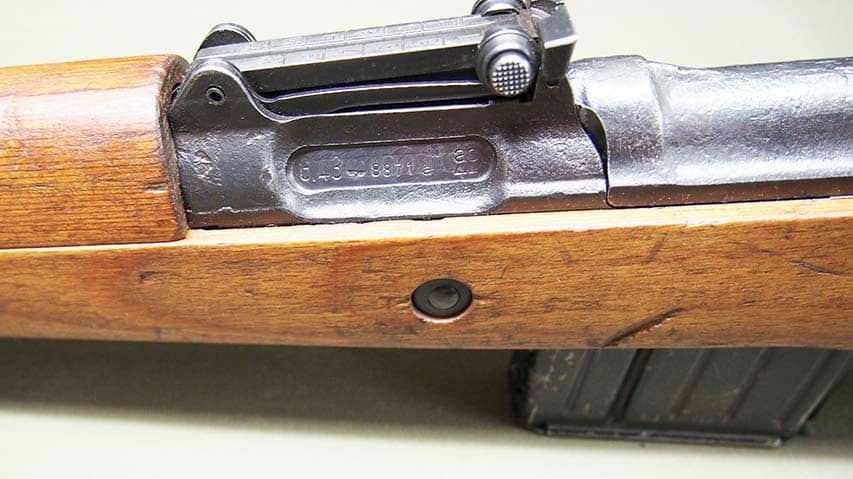
When it came to accuracy as a sniper rifle, the G43 has largely been considered the superior of the three weapons. As noted, the German Army planned to equip upwards of half of the G43s with a scope for use by marksmen and snipers. In fact of the 402,713 G43s that were produced, a total of 53,435 were outfitted as sniper rifles. These were fitted with Zielfernrohr 43 (ZF4) telescopic sights with 4x magnification.
By contrast, of the 1.6 million SVT-40s produced, less than 52,000 were the sniper variant—the Red Army found that the weapon performed poorly as a sniper rifle and terminated production of the sniper model in 1942. The U.S. Army tended to rely on the venerable M1903A4 Springfield for use by snipers, but in June 1944 adopted the M1C variant of the Garand to supplement demand. However, during World War II less than 8,000 of the M1C variant of the Garand were produced, and few saw active duty. During the subsequent Korean War, the United States Marine Corps adopted the M1C as its official sniper rifle.
Legacy of the WWII Semiautomatics
As noted above, the M1 Garand remained in use throughout the Korean War, and only in the 1950s was a replacement sought. There were attempts to “modernize” the M1 Garand by adding fully automatic firing capability and replacing the en bloc with a detachable box magazine. Numerous prototypes were developed, and this eventually led to the T44 prototype, which was finally adopted in 1957 as the M14—a rifle that would remain in use until the mid-1960s when it would be replaced with the AR-15/M16.
In the closing year of World War II, the Soviets also reconsidered the need for a semiautomatic battle rifle and interestingly noted that the size of the SVT-40 was an issue. At the same time, the Soviets had developed an intermediate cartridge between the 7.62x54mmR used in the Mosin-Nagant and SVT-40 rifles and the 7.62x25mm pistol cartridge that was also used in submachine guns such as the PPSh-41.
The 7.62x39mm was comparable to the intermediate round used in the German’s StG44, the world’s first true assault rifle. In 1943, even as production of the SVT-40 was being tapered off, Soviet designer Sergei Gavrilovich Simonov worked to develop the Samozaryadny Karabin sistemy Simonova (“self-loading carbine of the Simonov system,” 1945). It would more commonly be known as the SKS. Visually it does resemble a reduced SVT-40, but the operating systems are different—and any resemblance is likely due to the Soviet origin. However, the SKS did serve as intermediate step to the AK-47.
The G43 didn’t lead to any future gun development, due in no small part to the fact that Germany lost the War, and arms development essentially ended for a decade.
The greater legacy of all three weapons is that in the years after World War II, the age of the bolt-action rifle had truly come to an end.
| This article first appeared in Small Arms Review V24N3 (March 2020) |



